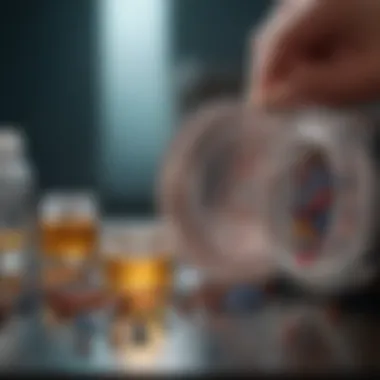Mirapex in Bipolar Depression: Insights and Applications


Intro
Bipolar depression presents unique challenges for both patients and healthcare providers. While traditional therapies focus primarily on mood stabilizers, increasing attention has turned toward alternative medications. One such medication is Mirapex, primarily known for its application in treating Parkinson's disease. Its role in bipolar disorder, particularly bipolar depression, is under investigation. Understanding this role requires a thorough exploration of its pharmacological properties, clinical effectiveness, and potential side effects.
This article aims to dissect the intersection of Mirapex and bipolar depression, offering both depth and clarity. By evaluating current research and its implications, the discussion will equip professionals and scholars with relevant knowledge necessary for navigating treatment options for this complex condition.
Article Overview
This section provides a framework for understanding the critical issues associated with the use of Mirapex in managing bipolar depression.
Summary of Key Findings
Mirapex emerges as a potential adjunct therapy in treating bipolar depression, particularly for patients who may not respond well to standard treatments.
- Effectiveness: Recent studies indicate that Mirapex may alleviate depressive symptoms in some patients while offering a favorable side effect profile.
- Side Effects: Though generally well-tolerated, Mirapex can present side effects such as nausea, dizziness, and, in some cases, compulsive behaviors.
- Research Insights: Current literature suggests a need for larger-scale studies to better define the medication’s role and establish solid treatment guidelines.
Research Objectives
The primary research objectives include:
- Assessing the impact of Mirapex on depressive symptoms in bipolar disorder.
- Understanding the pharmacological mechanisms that contribute to its effectiveness.
- Evaluating the safety and tolerability of Mirapex in various patient populations, especially those with co-morbidities.
The importance of delineating these objectives lies in the potential to enhance and diversify available treatment options for patients facing the challenges of bipolar depression.
Key Results and Discussions
The findings from recent studies offer valuable insights into Mirapex’s role in managing bipolar depression.
Main Findings
- Efficacy: Clinical trials reveal that Mirapex can significantly reduce the severity of depressive episodes in bipolar disorder, leading to potential improvements in overall functionality.
- Distinct Mechanism of Action: Mirapex primarily acts as a dopamine agonist, which may play a crucial role in mood regulation for individuals with bipolar disorder.
- Patient Variability: Not all patients exhibit similar levels of response, highlighting the necessity for personalized treatment plans.
Implications of Findings
The implications of these findings are multifaceted.
- Clinical Practice: Mental health professionals may consider Mirapex a viable option, positioning it as an adjunct to standard mood stabilizers, enhancing treatment strategies.
- Future Research: Further studies are necessary to explore the long-term effects of Mirapex in bipolar depression, focusing on optimal dosages and treatment protocols.
Mirapex could play an essential role in the therapeutic landscape for bipolar depression. Understanding its full potential requires ongoing scrutiny and comprehensive research.
Preamble to Bipolar Depression
Bipolar depression represents a critical aspect of bipolar disorder, affecting numerous individuals and their daily lives. Understanding this condition is vital as it can significantly impact treatment strategies and outcomes. This section will lay the groundwork for further exploration of Mirapex and its implications for bipolar depression management.
Understanding Bipolar Disorder
Bipolar disorder is a mood disorder characterized by extreme mood swings. These swings can range from manic highs, where individuals may feel euphoric or overly energetic, to depressive lows, which can include feelings of sadness, hopelessness, and a lack of energy. The complexity of this condition makes it essential to understand the various forms of bipolar disorder, such as Type I, Type II, and cyclothymic disorder.
People experiencing bipolar disorder often find it challenging to maintain consistent and stable emotions. As a result, relationships, employment, and general life satisfaction may be severely affected. Recognizing the symptoms and underlying mechanisms of bipolar disorder provides valuable insights into the management of bipolar depression.
Defining Bipolar Depression
Bipolar depression specifically refers to the depressive episodes that occur in the context of bipolar disorder. These episodes can vary in intensity and duration, leading to a range of functional impairments. Unlike unipolar depression, which is simply characterized by depressive symptoms, bipolar depression is intertwined with manic or hypomanic states.
Defining bipolar depression involves understanding its unique features. Symptoms may include:


- Persistent sadness or low mood
- Lack of interest in activities previously enjoyed
- Changes in appetite and sleep patterns
- Difficulty concentrating and making decisions
The recognition of these symptoms is crucial for accurate diagnosis and effective treatment. It is also necessary to differentiate bipolar depression from unipolar depression to tailor appropriate treatment plans.
Thus, this exploration sets the stage for discussing how medications like Mirapex can contribute to addressing bipolar depression and improving patient outcomes.
Overview of Mirapex
The overview of Mirapex is essential in understanding its application in bipolar depression. Mirapex, known generically as pramipexole, is primarily prescribed for Parkinson's disease and restless legs syndrome. Recent explorations, however, have suggested its utility in mood disorders, specifically bipolar depression. This section aims to dissect its pharmacological classification and mechanism of action—both are pivotal in grasping how this medication influences bipolar depression.
Pharmacological Classification
Mirapex belongs to a class of drugs known as dopamine agonists. These medications mimic the action of dopamine in the brain, a neurotransmitter that plays a significant role in mood regulation, motivation, and pleasure. In the context of bipolar disorder, where mood dysregulation occurs, the properties of dopamine agonists become crucial. By stimulating dopamine receptors, Mirapex has the potential to help alleviate depressive symptoms during the depressive phase of bipolar disorder. Unlike traditional antidepressants, which primarily target serotonin or norepinephrine reuptake, Mirapex's unique action makes it an intriguing alternative, meriting further exploration and research.
Mechanism of Action
The mechanism of action of Mirapex involves selective stimulation of the D2 and D3 dopamine receptors. This pathway can enhance dopaminergic tone, which may have a stabilizing effect on mood. It's known that in bipolar depression, there is often a dysregulation in dopaminergic signaling. By correcting this imbalance, Mirapex may provide relief from depressive episodes. Moreover, its impact extends beyond simple mood regulation; it may also improve other symptoms associated with bipolar disorder, such as anhedonia and psychomotor retardation.
Understanding these mechanisms is fundamental for healthcare professionals aiming to apply Mirapex effectively. Symptoms of bipolar disorder are complex and require tailored treatments that consider individual patient profiles. Thus, recognizing how Mirapex interacts at the neurochemical level equips clinicians with the knowledge to leverage its benefits in managing bipolar depression.
"Identifying how medications like Mirapex influence dopamine pathways can transform therapeutic strategies for managing bipolar depression."
In summary, this dual focus on pharmacological classification and mechanism of action establishes a solid groundwork for evaluating Mirapex as a viable treatment option in bipolar depression. Further sections will elaborate on clinical trial evidence, patient outcomes, and comparative analysis with other treatments, solidifying our understanding of this multifaceted medication.
Mirapex in Bipolar Depression
The role of Mirapex in treating bipolar depression warrants careful examination. Mirapex, primarily known for its application in Parkinson's disease and restless legs syndrome, has increasingly gained attention for its potential benefits in managing depressive symptoms within bipolar disorder. Understanding this connection is crucial, as bipolar depression often presents distinctive challenges compared to unipolar forms. The complexity of bipolar illness requires a nuanced clinical approach, and the inclusion of novel medications like Mirapex offers a progressive avenue for treatment.
Evidence from Clinical Trials
Research into the efficacy of Mirapex for bipolar depression is still emerging. Various clinical trials have focused on assessing its effectiveness and safety profile. One significant trial by the Royal College of Psychiatrists explored the use of Mirapex combined with traditional mood stabilizers and reported positive preliminary outcomes. Patients showed improvement in depressive episodes without significant exacerbation of manic symptoms.
- Increased patient engagement was noted, highlighting potential reductions in depressive severity.
- Other studies focused on specific biomarkers, suggesting that Mirapex may modulate neural pathways involved in mood regulation.
Nonetheless, data is limited and predominantly anecdotal at this stage. More large-scale randomized controlled trials are required to establish definitive conclusions.
Patient Outcomes
Patient outcomes are a critical aspect of evaluating any treatment regimen. In cases where Mirapex was used, feedback from healthcare providers indicated a mixed, yet encouraging, response. Many patients reported reduced depressive symptoms alongside manageable side effects. Furthermore, independent groups have noted improvements in overall quality of life, particularly in patients with treatment-resistant bipolar depression.
- Improvements were observed in mood stabilization for some patients.
- Important factors such as ease of compliance due to the oral administration route make it practical for long-term use.
However, caution is advised given the variability in individual responses. While some experienced significant benefits, others reported challenges with side effects, ranging from dizziness to nausea.
"It is essential to personalize treatment. Each patient reacts differently, and the integration of Mirapex must consider their unique backgrounds and health conditions."
Understanding these patient outcomes will guide future approaches and foster better treatment protocols for those coping with bipolar depression.
Comparative Analysis
The comparative analysis of Mirapex and alternative treatment options is crucial in understanding its role in managing bipolar depression. By examining both Mirapex and other forms of treatment, such as traditional antidepressants and various bipolar therapies, we gain insight into the effectiveness and potential benefits of Mirapex. This analysis provides a framework for practitioners to make informed prescribing decisions and helps to clarify whether the unique profile of Mirapex can meet the needs of specific patient populations. Different medications can have varied impacts on patients, suggesting the importance of personalized treatment plans.
Mirapex vs. Traditional Antidepressants
When comparing Mirapex to traditional antidepressants, several factors come into play. Traditional antidepressants, such as fluoxetine and sertraline, primarily target serotonin levels in the brain, which can help alleviate depressive episodes. However, for individuals with bipolar depression, these medications can sometimes trigger manic episodes, which complicates treatment. This risk leads to careful consideration of their use in this population.


On the other hand, Mirapex, which is primarily a dopamine agonist, operates through a different mechanism. By stimulating dopamine receptors, it may offer symptomatic relief without activating manic symptoms. Some studies suggest that Mirapex may be particularly beneficial in those with bipolar disorder, as it can address both depressive and manic symptoms in a more balanced manner.
Furthermore, the side effect profile of Mirapex can vary significantly from that of traditional antidepressants, which often have an array of common adverse effects including weight gain, sexual dysfunction, and insomnia. In contrast, Mirapex's side effects may be less bothersome, but can still include dizziness, nausea, and somnolence, requiring monitoring in a clinical setting.
"Understanding the distinct mechanisms and effects of these medications is vital for optimizing treatment in bipolar depression."
Ultimately, the choice between Mirapex and traditional antidepressants should involve an evaluation of each patient’s history, symptoms, and potential for side effects, emphasizing the importance of individualized treatment plans.
Mirapex and Other Bipolar Treatments
In addition to conventional antidepressants, Mirapex must be assessed in relation to other bipolar treatments. Mood stabilizers such as lithium or anticonvulsants like valproate are commonly used in treating bipolar disorder, but they may not address all aspects of bipolar depression effectively. Comparing Mirapex with these alternatives sheds light on its potential role in comprehensive treatment strategies.
Mirapex may provide an advantageous option when combined with mood stabilizers. By addressing dopamine dysregulation without the common risk of promoting mania associated with traditional antidepressants, it can potentially enhance overall treatment efficacy.
Considering adjunctive therapies is also essential. For example, psychotherapy is often a key component in managing bipolar depression. Some studies indicate that integrating Mirapex with therapeutic practices could yield improved patient outcomes, as a dual approach of medication and therapy usually addresses both biochemistry and behavioral aspects of the disorder.
Side Effects and Considerations
Understanding the topic of side effects and considerations when utilizing Mirapex in the treatment of bipolar depression is crucial for several reasons. This section provides insights into what healthcare professionals and patients might encounter throughout treatment. A careful examination of these factors is needed to deliver safe and effective care.
Common Side Effects
Mirapex, while used to manage symptoms of bipolar depression, can lead to a range of side effects. Common side effects include:
- Nausea: Often experienced during the initial phases of treatment.
- Dizziness: This may occur, especially when standing up quickly.
- Fatigue: Some patients report feeling more tired than usual.
- Insomnia: Difficulty in sleeping can arise in certain individuals.
- Mood fluctuations: As Mirapex interacts with brain chemistry, it may indirectly impact mood stability.
Understanding these side effects is important for both patients and practitioners. Properly assessing risks helps in determining whether Mirapex is a suitable option for a given individual.
Management of Side Effects
Effective strategies for managing side effects are vital to enhance patient adherence to treatment plans. Here are some approaches that can be utilized:
- Gradual Dose Adjustment: Starting with a lower dosage may help in minimizing side effects. Titration can allow the body to adjust to the medication gradually.
- Scheduled Monitoring: Regular consultations with healthcare providers can facilitate monitoring side effects closely. This approach allows real-time adjustments in treatment.
- Lifestyle Modifications: Encouraging healthier lifestyle choices such as regular exercise or proper hydration can mitigate some effects like fatigue and nausea.
- Patient Education: Educating patients about potential side effects promotes awareness, preparing them for what they may experience and encouraging timely communication with healthcare providers.
Contraindications and Warnings
When considering Mirapex for bipolar depression, specific contraindications and warnings should be adhered to:
- History of Psychosis: Patients with a history of psychosis may experience exacerbated symptoms.
- Severe Cardiovascular Issues: Those with heart problems should avoid Mirapex due to potential risks associated with blood flow changes.
- Allergic Reactions: Any previous allergic responses to Parkinson's medications should be taken into account, as these can indicate possible reactions to Mirapex.
"It is essential for healthcare professionals to evaluate a patient's complete medical background before prescribing Mirapex."
Awareness of these factors aids in assessing the safety of Mirapex for individual patients, ensuring that the benefits outweigh the potential risks. Overall, a thorough evaluation of side effects and considerations is vital in the context of treating bipolar depression with Mirapex.
Clinical Considerations
Understanding the clinical considerations surrounding the use of Mirapex in treating bipolar depression is crucial for effective patient management. This component of the article highlights how healthcare providers can monitor patient progress over time, address potential challenges, and tailor treatment approaches to individual needs. Such considerations play a vital role in ensuring the safety and efficacy of the treatment, particularly in complex cases where multiple factors may influence a patient's mental health status.
Long-term Use and Monitoring
Long-term use of Mirapex necessitates careful monitoring of both its therapeutic effects and potential adverse reactions. Regular follow-up appointments are essential. Clinicians must assess the patient's mood stability, side effects, and overall well-being. Monitoring can help detect any emerging patterns of side effects or shifts in mood that may require adjustment in dosage or a reevaluation of treatment strategy.
It is important for clinicians to be aware of several key points during monitoring:
- Assessment of dopamine agonist efficacy, as Mirapex primarily targets dopamine pathways.
- Evaluation of any significant behavioral changes, which could indicate issues like impulse control or increased risk of maladaptive behaviors.
- Regular blood tests to monitor liver function, as prolonged exposure to the medication can impact liver health.


In the broader context, incorporating patient feedback during monitoring can enhance the treatment plan. Understanding a patient's perception of their treatment responses can assist in refining clinical strategies.
Patient-Centric Treatment Strategies
Implementing patient-centric treatment strategies is essential to optimize the management of bipolar depression with Mirapex. This approach focuses on the unique requirements of each patient, allowing for flexibility in treatment aligned with individual preferences and lifestyles.
Key elements of patient-centric strategies include:
- Engaging patients in shared decision-making regarding their treatment options, encouraging them to voice their concerns and needs.
- Creating individualized plans that account for any co-morbid conditions, such as anxiety or substance use disorders, which often accompany bipolar disorder.
- Adjusting treatment plans based on patient feedback, efficacy of Mirapex, and nature of side effects experienced.
- Providing education on the use of Mirapex, its effects, and the importance of adherence to prescribed regimens.
By focusing on patient-centric strategies, healthcare providers not only enhance the effectiveness of treatment but also foster a stronger therapeutic alliance, which is crucial for lasting mental health outcomes.
"Effective treatment of bipolar depression requires a multifaceted approach, where understanding the patient's context is as important as the medication itself."
In summary, clinical considerations for Mirapex encompass long-term monitoring and the implementation of patient-centric treatment strategies. These aspects aim to enhance treatment efficacy, reduce side effects, and ultimately improve the quality of life for those living with bipolar depression.
Future Research Directions
Exploring future research directions in the context of using Mirapex for bipolar depression is vital for a comprehensive understanding of this treatment approach. Given the complexity of bipolar disorder and its varying presentations, targeted studies can illuminate unanswered questions regarding efficacy, dosage, and patient selection.
One essential aspect is to evaluate long-term outcomes of Mirapex use in bipolar depression. Longitudinal studies can provide insights into the sustainability of treatment effects and any late-emerging side effects. Research can also focus on how Mirapex interacts with existing medications for bipolar disorder, especially in patients with co-morbid conditions such as anxiety or substance use disorders.
Another key component lies in understanding the pharmacogenomics of Mirapex. Individual responses to medications like Mirapex can vary significantly based on genetic factors. Identifying specific biomarkers or genetic profiles that predict better outcomes could enhance personalized treatment plans for patients suffering from bipolar depression. Such individualized approaches are critical because they may reduce the trial-and-error phase of finding effective treatments.
Additionally, assessing the impact of Mirapex in various demographic groups—age, gender, and ethnicity—can elucidate its effectiveness across diverse populations. Research could explore whether there are disparities in treatment response or side effect profiles among different groups.
"Investing in thorough research will elucidate the complexities of treating bipolar depression with Mirapex, providing clarity where confusion currently exists."
By prioritizing these research areas, scholars and clinicians can contribute to more robust clinical guidelines, ultimately improving patient care in bipolar depression.
Identifying Gaps in Current Research
Despite significant strides made in understanding bipolar depression treatment, substantial gaps remain. A notable absence of knowledge relates to the optimized use of Mirapex. Much of the existing research has concentrated on traditional antidepressants, leaving the specific nuances of Mirapex underexplored. Current literature might lack comprehensive comparative studies that position Mirapex alongside other formulations within common treatment regimens.
Additionally, many studies utilize short follow-up periods, which renders the long-term effectiveness and potential withdrawal effects obscure. Understanding how to manage such aspects can enhance clinical practice and inform follow-up care in real-world settings.
Potential Research Avenues
Several promising research avenues can be pursued to address existing knowledge gaps. First, conducting randomized controlled trials with large sample sizes can provide more definitive evidence regarding the efficacy of Mirapex compared to existing antidepressant therapies. This can include analyzing different dosing strategies and treatment durations to determine the most effective protocols.
Moreover, qualitative research methods can also be valuable. Gathering firsthand patient experiences can identify previously overlooked factors influencing treatment success. Focus groups and interviews could enrich the data landscape, offering insights regarding the subjective experience of using Mirapex for bipolar depression.
Exploring the role of digital health interventions alongside pharmacological treatments may also be a fruitful area for investigation. Considering how technology can monitor symptoms or support adherence to treatment regimens could yield effective combined strategies.
In summary, addressing current research gaps and exploring new avenues can significantly enhance understanding and application of Mirapex in the context of bipolar depression, ultimately benefiting patient outcomes.
The End
The conclusion serves as a crucial section in the examination of Mirapex for bipolar depression. It synthesizes the insights gained throughout the article, emphasizing the importance of a comprehensive understanding of both the drug and the condition it aims to treat. In analyzing Mirapex, we have observed its potential efficacy, associated side effects, and how it compares to both traditional antidepressants and other treatment modalities. By encapsulating these findings, we not only reinforce the knowledge presented but also highlight the implications for future research and practice.
Summarizing Key Findings
In the exploration of Mirapex, several key points emerge:
- Efficacy of Mirapex: Clinical trials have shown that Mirapex may alleviate some symptoms associated with bipolar depression. Its mechanism of action, primarily through dopamine receptor modulation, presents a unique advantage compared to conventional treatments.
- Side Effects: Common side effects, such as nausea, dizziness, and fatigue, must be considered when prescribing Mirapex, as they may impact patient compliance and overall treatment effectiveness.
- Comparative Analysis: The comparative analysis reveals that Mirapex might offer benefits not fully realized with other standard antidepressants. This distinction can influence treatment choices, particularly in patients who do not respond adequately to traditional options.
Implications for Practice
The implications for healthcare professionals are significant. Understanding the nuanced role of Mirapex can guide treatment decisions and personalize therapeutic strategies. It is vital for clinicians to weigh the benefits against potential side effects, particularly in a population that may already grapple with complex mental health issues.
- Patient-Centric Approaches: Professionals should engage patients in discussions about treatment plans. This includes educating them on the benefits and risks of Mirapex to enhance adherence and manage expectations.
- Monitoring and Adjustment: Continuous monitoring of patient responses to Mirapex will be necessary for optimizing treatment outcomes. Adjustments may be warranted based on individual reactions.
- Future Considerations: As research continues to unfold, staying updated on new findings regarding Mirapex and its applications will enhance a clinician’s ability to provide the best care.
"By synthesizing research findings and aligning clinical strategies, practitioners can significantly improve the management of bipolar depression."







